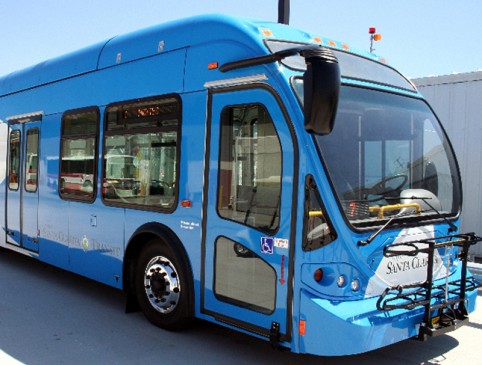SACRAMENTO – Caltrans announced Tuesday that 152 local projects received nearly $97 million in funding from the Low Carbon Transit Operations Program.
These projects, which include $218,511 in funding to the city of Santa Clarita to “increase ridership system-wide by creating and implementing a customer amenity and ridership marketing campaign,” continue California’s effort to reduce greenhouse gas emissions and improve the sustainability of public transportation systems around the state.
More than 130 projects totaling $87 million will specifically benefit the disadvantaged and low-income communities.
“This program is about making transit work better for more riders, funding expanded service and reducing fares, especially for those who face financial barriers to mobility,” said Caltrans Director Laurie Berman. “Providing accessible, reliable and affordable public transportation all feeds into promoting a healthier environment, better access to economic opportunity and a higher quality of life.”
The Low Carbon Transit Operations Program (LCTOP) is one of several state programs under the California Climate Investments which are funded through auction proceeds from the California Air Resources Board’s Cap-and-Trade Program into the Greenhouse Gas Reduction Fund. Funding from this program goes toward direct investments in transit projects that reduce greenhouse gas emissions and benefit Disadvantaged and Low-Income Communities and Households (defined by CalEPA) throughout California.
Some of the local projects that will benefit from LCTOP funding disbursements include:
· 31 Projects to Offer Free or Reduced Fares:
o Yosemite Area Regional Transportation (YARTS) to offer targeted populations from the City of Merced and Mariposa County reduced fares on public transit to access such sites as Yosemite National Park. $33,038
o Sunline Transit Agency to offer a College (Haul) Pass that will provide college students in the Coachella Valley free transit service. $696,048
o Southern California Regional Rail Authority (Metrolink) to offer roughly 80,500 free tickets for targeted populations including new generation transit riders and seniors. $2 million
· 51 Projects for New or Expanded Transit Service:
o San Francisco Municipal Transportation Agency (Muni) to expand transit service on San Bruno Rapid Line 9R, Folsom/Pacific Line 12, Sunset Line 29, the O’Shaughnessy Line 44 and the Quintara/24th Street Line 48. $2.6 million
o Fresno Department of Transportation (FAX) to expand weekday night service and increase frequency on weekend service. $350,000
o Omnitrans (San Bernardino County) to continue operating Route 290 Freeway Express that cuts travel time in half for passengers. $150,350
· 22 Projects to Purchase Replacement Zero-Emission Vehicles:
o San Diego Metropolitan Transit System (MTS) will purchase six electric buses, two hydrogen fuel cell buses and infrastructure in their pilot program to introducing zero-emission bus technology on their system. $2.6 million
o Eastern Sierra Transit Authority will purchase an electric vehicle and infrastructure for a dial-a-ride service. $26,411
o Santa Clara Valley Transit Authority (VTA) to purchase up to nine zero-emission battery electric buses and infrastructure. $3.9 million
· 15 Projects Purchasing, Constructing, and/or Installing Passenger Amenities at Transit Stops/Stations to Encourage Increased Transit Ridership:
o Humboldt Transit Authority will construct a bus stop to improve safety that will include the shelter, solar lighting and solar-powered real-time bus information. $75,000
o Madera County Transportation Commission (MCTC) will install multiple shelters and amenities within the City of Madera, the County of Madera and the City of Chowchilla. $95,635
o City of Torrance will install solar lighting at hundreds of bus stops in targeted communities. $173,830
This program was created to provide operating and capital assistance for transit agencies to reduce greenhouse gas emissions and improve mobility, with a priority on serving disadvantaged communities. Approved projects will support new or expanded bus or rail services, or expanded intermodal transit facilities. They may also include equipment acquisition, fueling and maintenance and other costs to operate these services or facilities, with each project reducing greenhouse gas emissions.
The Cap-and-Trade Program is one of many programs developed under AB 32 to fight climate change. It is designed to reduce greenhouse gases from the largest sources of emission in California, and to drive innovation and steer the State toward a clean energy economy. For more information on the Cap-and-Trade Program visit: http://www.arb.ca.gov/cc/capandtrade/capandtrade.htm.
Like this:
Like Loading...
Related





 Tweet This
Tweet This Facebook
Facebook Digg This
Digg This Bookmark
Bookmark Stumble
Stumble RSS
RSS


























REAL NAMES ONLY: All posters must use their real individual or business name. This applies equally to Twitter account holders who use a nickname.
1 Comment
STOP BUILDING AND CREATING REASONS FOR PEOPLE OUTSIDE SCV TO TRAVEL INTO OUR CITY . THAT THERE WILL LOWER OUR GREENHOUSE GASES. NO NEED TO SPEND MONEY . JUST STOP !!!!!!! THATS FREE